
The Resistance Medal 1940–1945 was a Belgian war medal established by royal decree of the Regent on 16 February 1946 and awarded to all members of the Belgian armed resistance during the Second World War and to members of the intelligence service who operated in occupied territories and participated in combat actions aimed at the liberation of Belgium.
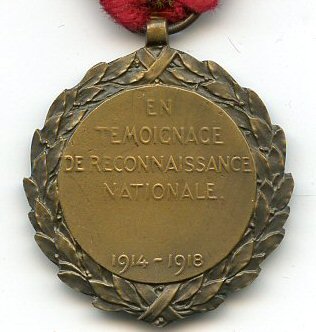
The King Albert Medal was a Belgian medal established by royal decree on 7 April 1919 and awarded to both Belgians and foreigners who were exceptionally meritorious in promoting, organising or administering humanitarian and charitable work that assisted Belgians in need during the First World War.
The Military Cross is a military long service decoration of Belgium. It was established by Royal Decree on 11 February 1885 and is awarded to commissioned officers in the Belgian Armed Forces for loyal and uninterrupted service or to Non-Belgian military officers for distinguished service in favor of the Military of Belgium.

The 1914 – 1918 Fire Cross was a Belgian military decoration awarded to all holders of the so-called "Fire Card" which was awarded to all who came under fire at the front during the First World War. The medal was established by royal decree on 6 February 1934. It could not be awarded posthumously.
The Civic Decoration is a civilian decoration of the Kingdom of Belgium. It was first established by royal decree on 21 July 1867 to reward exceptional acts of bravery, devotion or humanity. A further royal decree of 15 January 1885 extended the award to state civil servants for long service by a mere change of ribbon. The award statute was once again amended by royal decree in 1902 to include long service in the Civic Guard and firefighters, each with its distinctive ribbon.
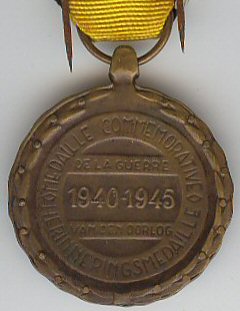
The Commemorative Medal of the 1940–45 War was a military decoration of Belgium. It was established by royal decree of the Prince Regent on 16 February 1945 to recognise Belgian servicemen and women who served during World War II. It was also awarded to members of the Belgian Resistance and members of Belgium's Merchant Navy on the side of the Allies. Later decrees allowed for its award to foreign recipients of the Belgian Croix de Guerre.
The Croix de guerre (French) or Oorlogskruis (Dutch) is a military decoration of the Kingdom of Belgium established by royal decree on 25 October 1915. It was primarily awarded for bravery or other military virtue on the battlefield. The award was reestablished on 20 July 1940 by the Belgian government in exile for recognition of bravery and military virtue during World War II. The post-1940 decoration could also be awarded to units that were cited. The decoration was again reestablished by royal decree on 3 April 1954 for award during future conflicts.

The Yser Medal was a Belgian campaign medal of World War I, established on 18 October 1918 to denote distinguished service during the 1914 Battle of the Yser in which the Belgian Army stopped the German advance of the German invasion of Belgium.

The 1940–1945 Military Combatant's Medal was a Belgian war medal established by royal decree on 19 December 1967 and awarded to all members of the Belgian Armed Forces who fought from the United Kingdom during the Second World War.

The Volunteer's Medal 1940–1945 was a Belgian war medal established by royal decree of the Regent on 16 February 1945 and awarded to Belgian and foreign civilians who voluntarily enlisted in the Belgian Armed Forces during the Second World War. The medal could also be awarded to volunteers serving in the Belgian units of the Royal Air Force, Royal Navy or British merchant navy.
The 1940–1945 Colonial War Effort Medal was a Belgian war service medal established by royal decree of the Regent on 30 January 1947 and awarded to government civil servants, magistrates, volunteer members of the female auxiliary service, missionaries, civilian agents of the different departments and civilians who served honourably for at least one year in the Belgian Congo or Ruanda-Urundi colonies of the Kingdom of Belgium in Africa between 10 May 1940 and 7 May 1945.
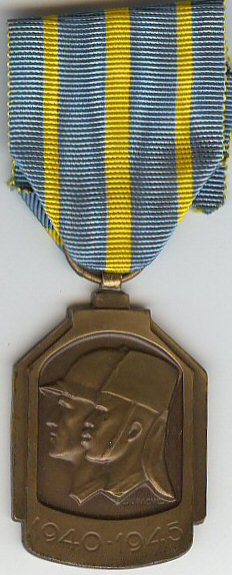
The 1940–1945 African War Medal was a Belgian war service medal established by royal decree of the Regent on 30 January 1947 and awarded to officers and soldiers for at least one year's service in the Force Publique between 10 May 1940 and 7 May 1945. This service was not limited to the Belgian colonies of the Congo and Ruanda-Urundi but also included the Middle East, Nigeria, Madagascar and Burma, for which clasps were awarded for six months service in those areas.

The Civilian Resistance Medal was a war service medal of the Kingdom of Belgium established by royal decree on 21 March 1951 and awarded to all members of the Belgian civilian resistance during the Second World War who were recognised as such by the law of 24 September 1946.
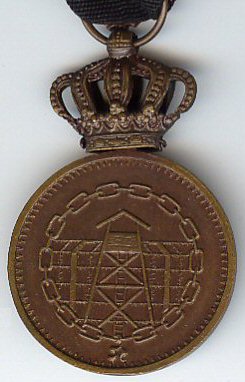
The Prisoner of War Medal 1940–1945 was a Belgian war service medal established by royal decree on 20 October 1947 and awarded to all members of the Belgian Armed Forces imprisoned by Axis Forces during the Second World War.

The Maritime Medal 1940–1945 was a Belgian bravery award of World War II, established by Royal Decree on 17 July 1941 and awarded to members of the Belgian Navy, merchant navy or fishing fleet for acts of heroism in the saving of ships or lives during an action against the enemy.

The Deportees' Cross 1914–1918 was a Belgian war medal established on 27 November 1922 by royal decree and awarded to Belgian citizens deported to Germany for forced labour during the First World War.
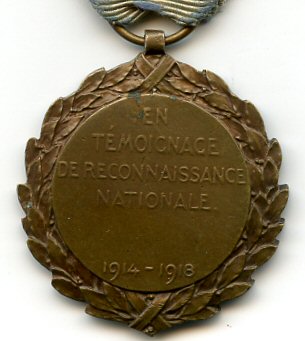
The Political Prisoner's Medal 1914–1918 was a Belgian medal established by royal decree on 26 December 1930 and awarded to Belgian civilians who were detained for a minimum of one month by the Germans during the First World War following an act of courage or devotion towards the Allies' cause.

In 1833, following the end of the Belgian Revolution, the young kingdom of Belgium created the Iron Cross to recognise wounds received and bravery in battle. The award first class was bestowed to the wounded who elected to stay at their post and keep fighting, to the maimed and mutilated, as well as for acts of courage, the award second class was bestowed to all wounded combatants. In 1835, due to the discontent of most recipients, the award 2nd class was terminated and all received the first class. Over the years, recipients of the Iron Cross received ever increasing pensions, up to ten years of seniority when employed as civil servants and pensions for the widows and orphans of the deceased. The other combatants of 1830-1831 received no pension, and no commemorative medal was struck.

The Iron Cross was established by law in 1833 following the end of the Belgian Revolution to recognise serious wounds received and bravery in battle by Belgian citizens taking part in the fight for Belgian independence from the United Kingdom of the Netherlands between 25 August 1830 and 4 February 1831. A further royal decree of 22 August 1834 created a second class to the Iron Cross for award to all wounded combatants. Due to the lower perceived importance of the second class award and discontent among recipients, the Iron Cross second class was short-lived and amalgamated to the Iron Cross first class by decree of 21 February 1835. All recipients now received the (original) first class award.
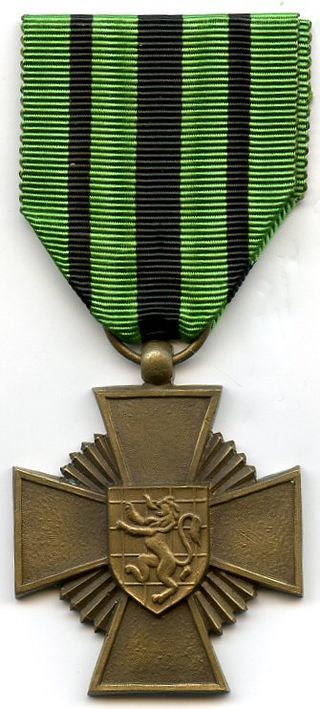
The Escapees' Cross 1940–1945 was a Belgian war service medal established on 25 February 1944 by the Belgian government in exile in London. It was awarded to all Belgian citizens who, during World War II, escaped from occupied Belgium, from another occupied land or from Germany and that, following said escape, had proven their patriotism by joining and serving with a resistance group, or had been imprisoned for a minimum of three months following an act of patriotism, or for having travelled clandestinely to participate in a Belgian action aimed at promoting the war against the enemy. Escaped prisoners of war could also be awarded the medal if they met this last criteria.



















